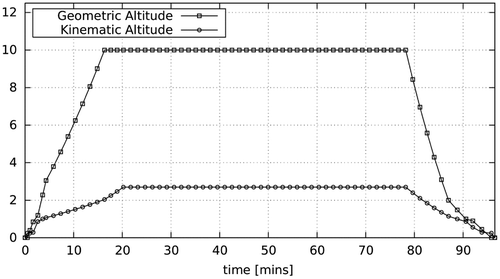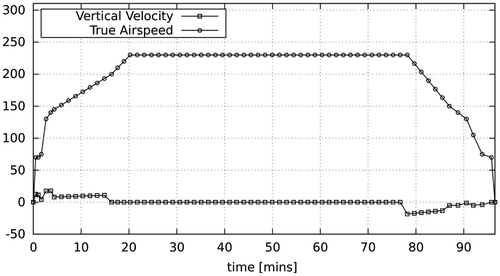Abstract
The current work deals with multi-objective optimisations including financial merit factors in the multi-disciplinary conceptual design of a commercial aircraft with a specific focus on noise social cost. The results of optimisations using financial and performance-oriented objective functions have been analysed and combined in a multi-objective optimisation problem using a three-dimensional objective vector. The main novelty of the present work is the analysis of social cost noise fees effectiveness integrated in financial models embracing a wider group of stakeholders’ interests. The foundations of this research lie on the air traffic increase envisaged in the next decades and the contextual growth of the urban areas nearby airport facilities. This scenario requires the aeronautical industry to handle the environment challenge taking into account all the social and economic effects. Indeed, the consolidated technology has approached a saturation point, therefore breakthrough concepts and configurations are mandatory. This matter is addressed as a highly multi-disciplinary problem within conceptual design framework. The financial model proposed is shown to highlight the need of appropriate noise fees as instruments to push all stakeholders towards a technology radical renewal and encourage the aeronautical industry towards a shared strategy in the development of an eco-friendly commercial aviation system.
1. Introduction
The key question about unconventional airplane configuration is: ‘what does one expect from innovative aircraft concepts?’ If you ask this question a frequent flier, he will tell you he wants to travel faster, safer and cheaper, while a member of a community living close to airport facilities will likely ask for a quieter and less polluting aircraft. From an airline company’s top manager’s perspective, it is key the reduction of costs, whereas a politician would probably focus on the reduction of the environmental impacts in terms of resources consumption, community noise and wastage production. Therefore, it is worth noting that the decision on what kind of aircraft will fly in 30 years is a complex, multi-disciplinary task which embraces different stakeholders’ needs and interests, and involves disciplines not pertaining exclusively to the aeronautics. As a logical consequence, a viable strategy to address the choice lies on the establishment of an innovative multi-disciplinary approach since the early conceptual phase of the design process.
Indeed, the air traffic is estimated to continue rising and so is expansion of urban areas close to airport facilities. In the next 25 years, a relevant growth in air traffic is likely to occur. Eurocontrol, the European Organisation for the Safety of Air Navigation, delivered a detailed forecast of air transportation traffic in a long-term perspective taking into account several different geopolitical scenarios. Majority of world Gross Domestic Product (GDP) is expected to derive from areas other than the European one. Therefore, the nature of the politic and commercial relationships between Europe and these areas plays a critical role in the expansion of the commercial and social exchanges. Inward- or outward-oriented politic and economic strategies of the European Union will consequently impact significantly the air traffic movements increase. Eurocontrol (Citation2013) has proposed four different scenarios for the 2050 forecast of air traffic movements, with an expected growth, compared to year 2012, from 90 to 170%. Furthermore, urban areas keep expanding close to airport facilities, strongly impacting the life quality of the communities who inhabit these neighbourhoods. For this reason, the International Civil Aviation Organization (ICAO) launched in 2001 and reaffirmed in 2007 the ‘balanced approach’ to aircraft noise management. Among the four elements to reduce noise problems they proposed, one can in fact find land-use planning and management (ICAO Citation2007).
In Europe, the Advisory Council for Aviation Research and innovation in Europe (ACARE) was settled in June 2001 and is composed of over 40 member organisations including governmental, private organisations, research institutes and academia. ACARE is an agency dealing with the improvement of the competitive situation of the European Union in aeronautics and air transport and indicated target reductions, relative to 2000 (Table 1), of 75% in CO2 emissions, of 90% in NOX emissions and of 65% in perceived noise by 2050 (ACARE Citation2011).
This situation is making the ecological footprint a feature of paramount relevance for the sustainable development of the transportation system. In this context, in the last decade, the European Community has consistently fostered scientific projects in order to develop solutions to reduce chemical and acoustical emissions. Consequently, chemical and acoustic pollution, impacting life quality of inhabitants of these areas, stirred political, economic and social interests. Within this context, it is understandable why the European Community allocated funds to scientific projects focusing on novel technologies and procedures to handle this issue.
Table 1. Summary of ACARE goals relative to 2000: comparison between Vision 2020 and Flightpath 2050.
Moreover it is easy to understand that, in a such challenging scenario, the introduction of breakthrough technologies is a key enabling factor since the consolidate technology is approaching a development saturation point and the incremental technological innovation is becoming progressively less effective in producing substantial improvements. An extensive literature review goes beyond the link between economic issues and environmental impact of aviation industry, and it is worth mentioning the work developed by Markish and Willcox (Citation2003) who linked financial considerations to performance factors. They also included the uncertainty analysis applying an approach developed in the finance environment to take into account the effect of substantial technical innovations. Antoine and Kroo (Citation2005) introduced the environmental impacts of aircraft within the conceptual design frame, in a multi-objective approach, as an objective function to be minimised. Furthermore, Hall et al. (Citation2013) analyses future air-cabins exploring both optimisation and win–win scenarios. With the aim of considering final consumers’ needs and value all stakeholders involved, they focus on customer-driven approach, even if still valuable are seen technical and design considerations. An additional relevant work is the one developed by Peoples and Willcox (Citation2006), whose focus lies on the financial uncertainties business risk assessment. The first investigation of the interdependencies between acquisition cost and negative externalities of a low-noise aircraft from an airline perspective has been presented in Iemma, Pisi Vitagliano, and Centracchio (Citation2015, Citation2016). In economics, an externality is a consequence of a business activity experienced by a party different than the ones involved in the activity itself, therefore negative externality are the costs affecting this party. Currently, according to the International Civil Aviation Organization policies (ICAO Citation2012), airline companies are charged with noise fees based on flight time and the class of the airplane. These incomes are supposed to be re-invested in the implementation of strategies and infrastructural improvements aimed at community noise abatement. It is worth noting that these charges are applied as air navigation fees when a flight is operated. This choice aims at internalising a negative externality, in fact the consequence due to the business activity has an economic impact on the party being the source of the inconvenience. Innovative configurations are then required not only to be financially sustainable but also socially sustainable.
Despite management of social costs deriving from negative externalities has been extensively explored, a complete literature review on this topic goes beyond the purpose of this paper. However, in the authors’ opinion, it is worth mentioning the article written by Calabresi and Melamed (Citation1972) who proposed four kind of rules to discipline inconveniences (the interested reader can found useful details in the Appendix 2): first, they discuss in detail the concept of entitlement, in order to clearly identify, in a conflictual situation, which part is entitled to prevail and then whether the entitlement is alienable in a voluntary transaction or, in the worst case, in a collective decision forced by the court. Following this approach, noise pollution has been managed assigning entitlement to inhabitants’ communities living nearby airport facilities, since the air traffic causes chemical and acoustical pollution over a large community inhabiting areas nearby airport facilities. The fair value has been identified including in the financial model the estimate of the equivalent cost of noise according to the most recent achievements on the topic (Grampella et al. Citation2013; Iemma and Diez Citation2005; Schipper Citation2004).
However, the discussion on how to deal with acoustic emissions is still open. One possible option is to switch from noise fees to noise taxes, with the not negligible implication for airliners to be charged for the ownership of noisy aircraft, and not any more for their actual operation. A detailed analysis of this hypothesis from the legal and economic point of view is not the purpose of this work. Notwithstanding, it is essential to point out that the legal detailed study should consider several operational complications among which a critical one is the identification of the subject and the country supposed to be collecting the cash flows deriving from these taxes. These speculations, regardless of their development, testify the existence of a strong economic interest among airline companies and, on top of the expansion of urban areas and the growth of air traffic, show that social and political concerns can have an impact on noise fees determination.
1.1. The aim of this work
Innovative configurations of airplanes have been widely explored during the last two decades and the majority of the technical issues have been identified. The solution strategies for some of them have been determined, whereas for others the aeronautical research community is spending substantial efforts, with continuous advancements. In any case, the undoubted existence of these technical aspects cannot be considered any more a justification of the lack of common strategies in the identification of the next generation of commercial aircraft. So why must we expect to keep watching tube-and-wings configurations flying our skies at least for other 25/30 years? Most likely because manufacturers have not yet converged onto a common strategy for the development of the next generation of airliners. Why? Is this delay only driven by technical reasons? We do not think so. A not negligible cause can lie on the not completely disclosed economic impact of these unconventional concepts. The pervasive effect of an unconventional concept on the entire logistic/infrastructural framework imposes the life-cycle costs analysis to be addressed by all the stakeholders in a synergistic fashion, and integrated as early as possible in the design process in a renewed multi-disciplinary fashion. It is therefore clear that in order to develop a cost-effective analysis it is key that economic and financial considerations impacting the whole design process are included from the conceptual design phase.
This work deals with the problem described above from the designer perspective, trying to develop an updated multi-disciplinary context technically, environmentally and economically sound, ready for the upcoming generation of aircraft. The authors address the conceptual design of eco-friendly aircraft integrating technical features with economic considerations. The final purpose is the analysis of financial and social sustainability of innovative airplane configurations which are foreseen to be launched in the next 30 years in order to reduce the environmental footprint of commercial aviation. Economic and environmental considerations merge when the analysis has to be integrated with the monetary implications related to acoustic emissions.
A multi-objective optimisation campaign has been performed in order to identify the aforementioned configurations, introducing original economic models within the multi-disciplinary design framework FRIDA – FRamework for Innovative Design in Aeronautics (see the Appendix 1 for details), developed by the authors and their collaborators during the last decade. The results presented here have been obtained using a derivative-free global optimisation method based on the metaphor of a swarm of bees in search of food. The Particle Swarm Optimisation (PSO) method used is the deterministic version of that introduced in Kennedy and Eberhart (Citation1995), presented in detail in Campana et al. (Citation2013), Diez et al. (Citation2014).
The work is organised as follows. Section 2 describes the financial model used, highlighting its relationship with the models proposed in the literature. Section 3 formalises the multi-objective optimisation problems, and numerical results are presented in Section 4. Here, the analysis is limited to conventional aircraft concepts in order to validate the basic assumptions on well-assessed concepts. Section 5 introduces the developments foreseen in the near future.
2. The financial model
The decision on innovative airplane configurations introduction embraces several stakeholders’ interests, which implies a point of equilibrium among the three following systems: environment, aircraft and community. In order to include benefits and drawbacks of the different stakeholders involved, it is valuable to develop an aircraft conceptual design which incorporates both technical and financial features.
Financial aspects from the manufacturer’s perspective have been investigated and, among the others, the authors believe it is worth mentioning the work written by Markish and Willcox (Citation2003) who modelled design and manufacturing costs. On one hand, according to Porter’s five forces analysis, within the aeronautical industry, suppliers have a strong bargaining power, on the other hand airline companies already engaged manufacturers in discussions about future planes, and they can be also considered the contact point between the travellers, the manufacturers, the environment and the infrastructure. In order to identify the best investment within a pool of potential mutually exclusive ones, a company has to compute the Net Present Value NPV of each one. NPV is calculated as follows:(1)
where N represents the number of years of investment life, r is the discount rate, and CF are the Cash Flows, both positive (PCF) and negative flows (NCF), related to the j-th year of service:
(2)
2.1. Positive cash flows
Inflows, i.e. the positive cash flows PCFj, are related to revenues coming from ticket sales at the j-th year, and have been computed with the following simple formula:(3)
being Ns the number of seats, ps the average price per seat, NM the number of flights per year, Or the occupancy rate and i the inflation rate.
2.2. Negative cash flows
The negative cash flows NCFj include the acquisition price PAC in addition to the most relevant direct operating costs i.e. the fuel cost, the maintenance cost and social costs related to noise pollution, according to Ferjan (Citation2014). Negative cash flows are calculated as it follows:(4)
being CF the fuel cost, CM the maintenance one and CN, the monetary impact of sound emissions, i the inflation rate.
2.2.1. Acquisition price
Outflows at year 0 are therefore equal to the acquisition price of the plane, as mentioned above. From an airline perspective, the initial investment equals the acquisition price which is not determined by the design costs. Of course, from a manufacturer’s viewpoint the airline acquisition price is its source of revenue which has to exceed manufacturing costs, including design ones, however being the commercial planes market regulated by the laws of supply and demand, acquisition price is not determined by costs but by the value perceived by the purchaser. Markish and Willcox (Citation2003) analysed the features bringing value to airline companies, considering that a variation in operating costs would be offset by a change in selling price in a zero-sum approach. Indeed, in this paper, acquisition price has been related to elements determining profits which are driven by aeronautical performance and internal airplane characteristics, passengers’ comfort and seat features. Maximum speed vmax and balanced field length BFL define the first set whereas the second one is composed of seats number, width and pitch seat. In this paper, the authors follow the approach proposed by Ferreri (Citation2003) who calculates the aircraft price through the following empirical formula:(5)
being Ns the number of seats, Vmax the maximum aircraft speed, Ps the seat pitch (i.e. the space between two consecutive rows of seats), Ws the seat width and BFL the balanced field length.
2.2.2. Direct operating costs
Outflows at later years correspond to the direct operating costs, increased by the inflation rate. Fuel cost CF, accounting for 33% of operational costs (see Ferjan Citation2014) is the most impacting cost item. It has been calculated as follows:(6)
being M is the distance covered in an average mission, NM the average yearly flights number, PF the fuel price, KF the consumption of the aircraft.
The second most impacting cost item is maintenance cost CM which accounts for 9% of operational costs (Ferjan Citation2014). It has been historically calculated as directly proportional to the acquisition price, for the high cost of a technological product would require expensive spare parts and more specialised workforce. The authors follow this approach, being aware of an opposite perspective is respectable based on the assumption that benefits deriving from low manufacturing costs could be charged within the selling price by the manufacturer as an additional value delivered to the purchaser.
Noise pollution has a critical impact on the inhabitants of boroughs nearby airport facilities causing a decrease in property value which is affected by both internal features and external factors. Schipper (Citation2004) deeply analysed hedonic pricing methods, including willingness to pay and then Grampella et al. (Citation2013) developed an empirical method to calculate the properties loss of value as follows:(7)
being NM the average yearly flights number and ANE the Average Noise Exposure that is to say the SEL average value measured in approach, flyover and lateral points as defined by ICAO certification.
3. Setting up the optimisation problems
With the purpose of identifying the most appropriate configuration, the authors restricted their analysis to a specific class of airplanes (164-pax), identifying a standard reference mission (modelled on 100-min flight, a classic European air route) and an average number of flights per year (2000 trips per each aircraft year of service). Subsequently, several multi-optimisation problems have been explored in order to determine the trade-off solution including performance, environmental and financial factors.
Solving multi-objective optimisation problems implies to identify the variables vector x in the n-dimensional design space D corresponding to a minimum (or a maximum) of the objective functions Jk(x), with all the inequality constraints g(x) and equality constraints h(x) satisfied. In case of conflicting objectives, the optimality criterion lies on the existence of a set of solutions such that it is possible to further minimise one objective solely at the expense of at least another one: such solutions are called non-dominated and constitute the Pareto front. The selection of a single optimal solution among the Pareto solutions may involve the choice of a further objective, in the present work referred to as the merit factor Ψ(x), aimed at the ranking of the optimal solutions.
The first optimisation problem (OPT-0) is basically performance-oriented, and involves the amount of consumed fuel Wf and the ANE, average acoustic emissions at certification points, as objective functions(8)
while the Net Present value NPV for an airline company could be taken as merit factor Ψ(x), suitable for the choice of the appropriate solution among Pareto front.
However, for the latter, the main goal is to achieve their NPV maximisation which does not necessarily occur along the Pareto frontier of the performance-oriented problem. Therefore, two additional optimisation problems have been studied. The first one (OPT-1) is characterised by Wf and NPV as objective functions(9)
and burnt fuel quantity Wf as merit factor Ψ(x) while in the second one (OPT-2) NPV and ANE are objective functions
(10)
and Wf is the merit factor Ψ(x).
Finally, a three-dimensional optimisation problem (OPT-3) has been explored, where NPV and ANE and Wf quantity are objective functions
(11)
whereas the aircraft acquisition price PAC has been chosen as merit factor Ψ(x), with the aim of investigating the link between the initial investment and its profitability.
A summary of the performed optimisation analysis is presented in Table .
Table 2. Summary of the performed optimisation analysis.
3.1. Design space
The design space is such as the wing system can be meaningfully reshaped during the optimisation process. The optimisation variables are related to the shape of the wing in terms of span, chords and thickness ratios (at root at tip location), twist angle (i.e. the attack angles at root and tip location), sweep angle, dihedral angle and flap geometry (in terms ratio of the flap span to the wing span, and flap chord to the wing mean aerodynamic chord). The design variables with their bounds are summarised in Table .
Table 3. Design variables related to the 164-pax aircraft: reference values, lower bounds and upper bounds.
The fuselage size is imposed by the aircraft class and the tail geometry (both the horizontal and the vertical stabiliser) is assumed fixed. The reference mission profile is shown in Figures and : it has been modelled, as mentioned above, on a typical 100-min European air route. The cruise altitude is 10.000 m and the cruise Mach number is 0.78. Both the take-off and approach procedures are regulations compliant.
3.2. Optimisation constraints
For the reference configuration (see Table ) the vertical equilibrium is imposed for the cruise condition:
(12)
being Lc the lift and Wc the aircraft weight evaluated at the cruise mid-point. The high-lift devices combined with the fuselage angle of attack ensure the stall prevention during the entire mission. The engines operating points are such that the overspeed is never exceeded and the rotational speed never passes under the idle condition:
(13)
with αmax the stall angle (function of the high-lift devices settings), N1os and N1i, respectively the engine overspeed and idle condition in terms of revolution-per-minute. Furthermore, the change in the wing geometry prompts modifications in aerodynamic, structural and inertial characteristics of the aircraft, thus the following constraints have been imposed:
(14)
being vmax = min[vf, vNE] the maximum acceptable velocity (with vf the flutter velocity and vNE the never-exceed velocity, in compliance with the FAR regulations), σmax and τmax, respectively, the maximum normal stress and the maximum shear stress at the root of the wing. Finally, since all the aircraft must be certified with regard to the noise emissions, three additional constraints were also imposed
(15)
where the subscripts Tf, Ts and A denote, respectively, the take-off flyover, the take-off side-line and the approach certification points whereas the superscript c is related to the values of the noise certification requirements.
4. Results and discussion
The optimisation analyses have been conducted within the framework FRIDA – FRamework for Innovative Design in Aeronautics (for details see the Appendix 1). It is important to point out that the original constrained problem has been replaced by others unconstrained problems, defining a pseudo-objective function which includes the constraints using the well-known quadratic penalty function method. The minimisation is provided by a gradient-free method, the Particle Swarm Optimisation (PSO), introduced by Kennedy and Eberhart (Citation1995), implemented by the Resistance & Optimisation team of the CNR-INSEAN (Campana et al. Citation2013). The problems were solved making use of 300 iterations and 110 particles, i.e. 33.000 objective function evaluations. It has been noted that the computational cost of each objective function evaluation lies almost exclusively in the noise evaluation, since the aeroacoustics models are called a number of times equal to the number of trajectory samples Ns multiplied by the number of virtual microphones Nmic: such consideration leaves us to assume that, since the framework FRIDA modules are (whenever possible) prime-principle based, the computational burden for unconventional aircraft configurations analysis may be of the same order of magnitude.
For all the analysed problems, the feasible solutions and approximated Pareto fronts have been determined and presented. The latter have been normalised with regard to the values related to a comparable currently flying aircraft.
The feasible solutions of the optimisation problem OPT-0 (see Table ), aimed at minimising both the consumed fuel Wf and acoustic emissions ANE, are shown in Figure and its normalised Pareto front is depicted in Figure .
Figure 3. Feasible solutions (normalised with regard to the values related to a comparable currently flying aircraft) of multi-objective optimisation aimed at minimising the acoustic emissions ANE and the fuel consumption Wf.
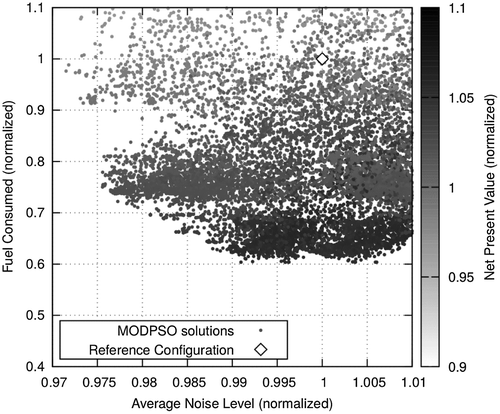
Figure 4. Pareto front of multi-objective optimisation aimed at minimising the acoustic emissions ANE and the fuel consumption Wf.
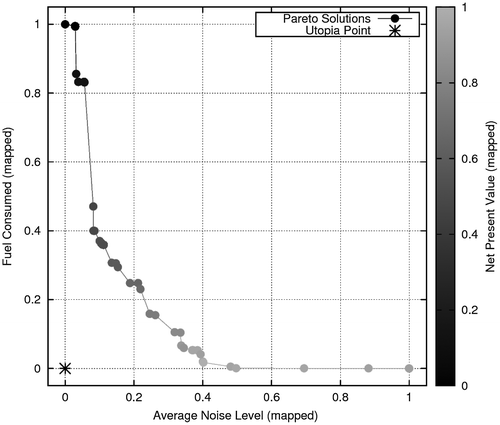
Along the approximated Pareto front, the solution identified by the maximum NPV could represent the best trade-off considering performance factors and economic interest of airline companies. It is worth noting it is close to the solution characterised by the minimum distance from utopia point.
However, airline companies would try to influence the market to introduce aircraft configurations maximising their NPV and its maximum value is associated with a feasible solution which may not lie on the Pareto front. Which is thus the connection between the Net Present Value NPV and the quantities describing the performance of the aircraft?
The link between the fuel consumed Wf and the investment profitability NPV can be found in the case OPT-1 (see Table ): feasible solutions and normalised Pareto front of such optimisation problem are respectively represented in Figures and .
Figure 5. Feasible solutions (normalised with regard to the values related to a comparable currently flying aircraft) of multi-objective optimisation aimed at maximising NPV and minimizing fuel consumption Wf.
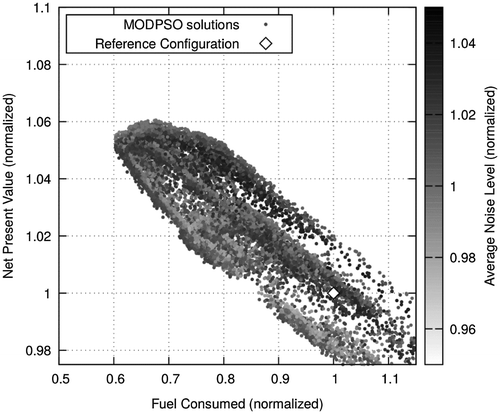
Figure 6. Pareto front of multi-objective optimisation aimed at maximising NPV and minimising fuel consumption Wf.
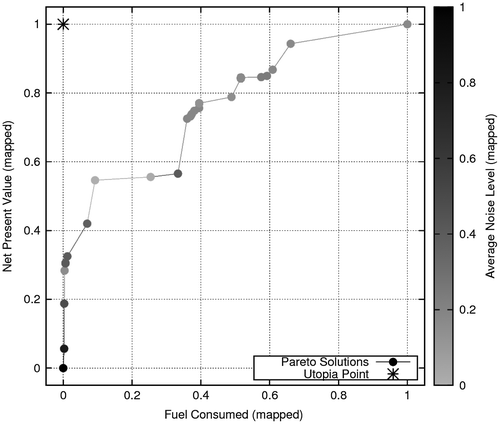
The shape of the front shows that these objective functions are moderately concurrent. However, observing the feasible solutions, one can notice a trend showing that a fuel consumption decrease is related to an NPV increase, up to a threshold. This is consistent with the cost analysis which shows that fuel cost accounts for 1/3 of total annual cost, therefore it is the most impacting cash outflow item. It is also according to the actions airline companies realise in order to reduce their fuel consumption. Indeed, the connection between the investment profitability NPV and the acoustic emissions ANE is observable in the problem OPT-2 (see Table ): feasible solutions and normalised Pareto front are represented in Figures and .
Figure 7. Feasible solutions (normalised with regard to the values related to a comparable currently flying aircraft) of multi-objective optimisation aimed at maximising NPV and minimising acoustic emissions ANE.
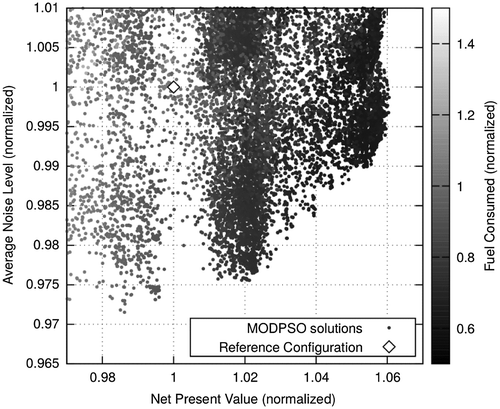
Figure 8. Pareto front of multi-objective optimisation aimed at maximising NPV and minimising acoustic emissions ANE.
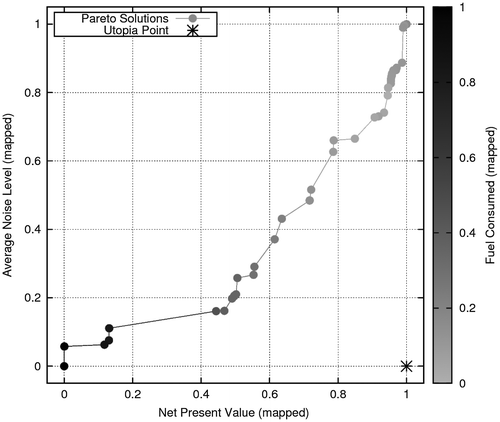
The shape of this Pareto front shows the objective functions are highly concurrent and this implies that airline companies would not be motivated to reduce noise at source unless differently encouraged either by the market or the regulatory authority. However, observing the feasible solutions, one can note a threshold which delimits an area where noise costs have almost no impact on NPV. In this area, NPV is limited to 105% of reference NPV while noise emissions range from 99 to 103% of reference emissions. This means that airline companies have no financial interest to decrease their acoustic emissions and if further noise reduction is required, noise fees are to be more influential. Several options could be implemented in order to achieve this goal. Among the others, we would like to list the two most common: airline companies exceeding an established by law maximum value can be charged a higher fee, or can be required to trade ‘noise certificates’ issued by virtuous companies producing noise below the limit. Nevertheless, a deep economic analysis of these policies goes beyond the purpose of this paper and the conceptual design phase.
In order to include in a more complete analysis, both performance and financial factors, a three-dimensional multi-objective optimisation problem has been explored (OPT-3, see Table ). Objective functions are acoustic emissions ANE, fuel consumption Wf and Net Present Value NPV. Feasible solutions and Pareto front are shown in Figures and .
Figure 9. Feasible solutions (normalised with regard to the values related to a comparable currently flying aircraft) of multi-objective optimisation aimed at maximising NPV and minimising both acoustic emissions ANE and fuel consumption Wf.
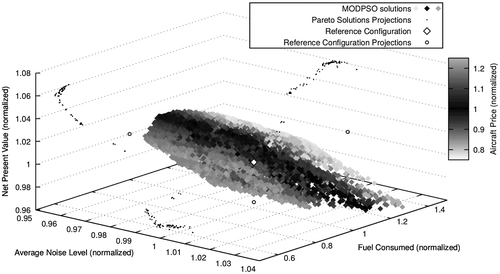
Figure 10. Pareto front of multi-objective optimisation aimed at maximising NPV and minimising both acoustic emissions ANE and fuel consumption Wf.
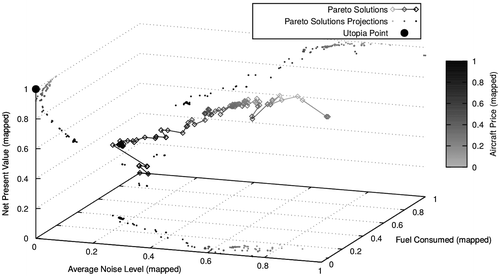
Analysing the range of the three-dimensional problem, one can note that maximum NPV is achieved in correspondence to a low fuel consumption and to an average emissions level, 99% of reference acoustic pollution. From this perspective, therefore it is evident that airlines have interest to maintain the current noise level and it reinforces the conclusion that in order to achieve a further reduction, noise fees are to be more impacting. For any company, the initial investment is a factor to take into consideration, since financial resources are finite and accordingly investments are limited too. However, it is also worth highlighting that high NPVs are characterised by high airplane costs which is consistent with manufacturers willing to monetise the value they deliver to airline companies.
5. Future developments
This paper explores tube-and-wings aircraft conventional configurations, analysing several optimisation problems. Since the current technology has approached a saturation point, innovative configurations are to be included in the analysis in order to further enhance it. Within this scope, it is also relevant to expand the model to include financial repercussions due to infrastructural impacts for innovative configurations. These impacts might consist of, and are not limited to, runways extension, jet-ways redesign, terminal enhancements. It is worth noting that this improvement is currently under development.
Furthermore, since this analysis deals with long-term forecasts, involving technological innovation, it embraces a high level of uncertainty. Uncertainties can be split into aleatory and epistemic ones, being the former related with stochastic variables (e.g. the cost of oil or demand/offer air traffic) and the latter associated to variables whose value is unknown for a lack of knowledge (future technologies, future policy decisions). The model is currently under development in order to consider and properly manage these uncertainties.
Finally, the financial model characteristics values could be refined based on a more accurate economic forecast analysis.
Disclosure statement
No potential conflict of interest was reported by the authors.
Notes on contributors
Umberto Iemma is an associate professor of Aerospace Structures and Design currently in charge of the courses in Engineering Mechanics for the bachelor degree in Mechanical Engineering and Multidisciplinary Aircraft Design for the master’s degree in Aeronautical Engineering, at the Roma Tre University. His primary research interests are the multidisciplinary design optimisation of eco-friendly aircraft, the theoretical and numerical modelling in acoustics, aeroacoustics and aerodynamics. He coordinates the activity of the Aircraft Design Laboratory at Roma Tre University. He also coordinates the development of the multidisciplinary aircraft design optimisation toolbox FRIDA (FRamework for Innovative Design in Aeronautics), successfully adopted as primary analysis platform in many FP7, Clean Sky and H2020 projects. Member of the NATO expert panels AVT-252 (Stochastic Design Optimisation) and AVT-233 (Aeroacoustics of Engine Installation). Author of more than 130 scientific papers published on peer-reviewed scientific journal or presented at international conferences.
Fabio Pisi Vitagliano has a PhD in Mechanical Engineering with a thesis on multisciplinary conceptual design of eco-friendly commercial aircraft. He obtained the International MBA at the IE Business School, one of the top-ranked programmes in the world according to Financial Times standings. Currently is a professor Human Resources Management, Leadership and Communication at the Rome Business School for both postgraduate and MBA programmes. His professional background includes experiences as a Corporate Trainer, Program Manager, Business Developer and Strategy Consultant at worldwide leading companies.
Francesco Centracchio has a PhD in Mechanical and Industrial Engineering with a research on physical modelling of musical instruments for real-time simulations. Has developed a highly multidisciplinary teaching experience in flight dynamics, aircraft technologies, engineering mechanics, aircraft design, piano technique, music theory in academia and high school. He is currently research fellow in the group of multidisciplinary design optimisation of aircraft at the Roma Tre University. His primary research interest is the robust optimal design of unconventional, highly innovative low-noise aircraft. He is currently the main developer of the design optimisation toolbox FRIDA (FRamework for Innovative Design in Aeronautics).
References
- ACARE. 2011. Flightpath 2050 – Europe’s Vision for Aviation. Technical Report, Advisory Council for Aviation Research and Innovation. Luxembourg: Europe Publications Office of the European Commission. ISBN 978-92-79-19724-6. doi:10.2777/50266.
- Antoine, N. E., and I. M. Kroo. 2005. “Framework for Aircraft Conceptual Design and Environmental Performance Studies.” AIAA Journal 43 (10): 2100–2109.10.2514/1.13017
- Calabresi, G., and A. D. Melamed. 1972. “Property Rules, Liability Rules and Inalienability: One View of the Cathedral.” Harvard Law Review 85: 1089–1128.10.2307/1340059
- Campana, E. F., M. Diez, G. Fasano, and D. Peri. 2013. “Initial Particles Position for PSO, in Bound Constrained Optimization.” Paper Presented at the 4th International Conference in Swarm Intelligence, Harbin, June 12–15.
- Diez, M., and U. Iemma. 2012. “Multidisciplinary Conceptual Design Optimization of Aircraft Using a Sound-Matching-Based Objective Function.” Engineering Optimization 44 (5): 591–612.10.1080/0305215X.2011.591791
- Diez, M., A. Serani, C. Leotardi, E. F. Campana, D. Peri, and U. Iemma. 2014. “A Proposal of PSO Particles’ Initialization for Costly Unconstrained Optimization Problems: ORTHOinit.” Paper Presented at the 5th International Conference in Swarm Intelligence, Hefei, October 17–20.
- Eurocontrol. 2013. Challenges of Growth 2013 – European Air Traffic in 2050. Technical Report, EUROCONTROL – European Organisation for the Safety of Air Navigation.
- Ferjan, K. 2014. “Airline Cost Management Group.” Presented at the Airline Cost Conference, Geneva, August 26–27.
- Ferreri, D. 2003. Marketing and Management in the High-Technology Sector. Westport, CT: Praeger.
- Fink, M. R. 1977. Airframe Noise Prediction Method. Technical Report, FAA.
- Fink, M. R. 1976. “Approximate Prediction of Airframe Noise.” Journal of Aircraft 13 (11): 833–834.10.2514/3.58718
- Grampella, M., M. G. Martini, D. Scotti, F. Tassan, and G. Zambon. 2013. “The Environmental Costs of Airports’ Aviation Activities: A Panel Data Econometric Analysis of Italian Airports.” Paper Presented at the 17th Air Transport Research Society World Conference, Bergamo, June 26–29.
- Hall, A., I. Wuggetzer, T. Mayer, and P. R. N. Childs. 2013. “Future Aircraft Cabins and Design Thinking: Optimisation vs. Win-Win Scenarios.” Journal of Propulsion and Power Research 2 (2): 85–95.10.1016/j.jppr.2013.04.001
- Heidmann, M. F. 1979. Interim Prediction Method for Fan and Compressor Source Noise. Technical Report, NASA.
- ICAO. 2007. Assembly Resolution in Force. Technical Report, International Civil Association Organization.
- ICAO. 2012. ICAO’s Policies on Charges for Airports and Air Navigation Service. Technical Report, International Civil Aviation Organization.
- Iemma, U., L. Burghignoli, F. Centracchio, and V. Galluzzi. 2014. “Multi-Objective Optimization of Takeoff and Landing Procedures: Level Abatement vs Quality Improvement of Aircraft Noise.” Paper Presented at the 43rd International Congress on Noise Control Engineering, Melbourne, November 16–19.
- Iemma, U., and M. Diez. 2005. “Optimal Life-Cycle Costs Design of New Large Aircraft including the Cost of Community Noise.” Paper Presented at the International Conference on Computational & Experimental Engineering and Sciences, Chennai, December 1–6.
- Iemma, U., M. Diez, C. Leotardi, and F. Centracchio. 2011. “On the Use of Noise Annoyance as a Design Optimization Constraint: The COSMA Experience.” Paper Presented at the 18th International Congress on Sound and Vibration, Rio De Janeiro, July 10–14.
- Iemma, U., M. Diez, and V. Marchese. 2006. “Matching the Aircraft Noise to a Target Sound: A Novel Approach for Optimal Design under Community Noise Constraints.” Paper Presented at the 13th International Congress on Sound and Vibration, Vienna, July 2–6.
- Iemma, U., F. Pisi Vitagliano, and F. Centracchio. 2015. “Life-Cycle Costs and Infrastructural Investments Induced by Unconventional Low-Noise Aircraft.” Paper Presented at the 44th International Congress on Noise Control Engineering, San Francisco, August 9–12.
- Iemma, U., F. Pisi Vitagliano, and F. Centracchio. 2016. “Multi-Objective Design Optimization of Sustainable Commercial Aircraft: Performance and Costs.” International Journal of Sustainable Engineering 10 (3): 147–157.
- Kennedy, J., and R. C. Eberhart. 1995. “Particle Swarm Optimization.” Paper Presented at the International Conference on Neural Networks, Perth, November 27–December 1.
- Markish, J., and K. E. Willcox. 2003. “Value-based Multidisciplinary Techniques for Commercial Aircraft System Design.” AIAA Journal 41 (10): 2004–2012.10.2514/2.1890
- Morfey, C. L., and M. J. Fisher. 1970. “Shock-wave Radiation from a Supersonic Ducted Rotor.” Aeronautical Journal 74 (515): 579–585.
- Morino, L. 1993. “Boundary Integral Equations in Aerodynamics.” Applied Mechanics Reviews 46 (8): 445–466.10.1115/1.3120373
- Morino, L., F. Mastroddi, R. De Troia, G. L. Ghiringhelli, and P. Mantegazza. 1995. “Matrix Fraction Approach for Finite-state Aerodynamic Modeling.” AIAA Journal 33 (4): 703–711.10.2514/3.12381
- Peoples, R. E., and K. E. Willcox. 2006. “Value-based Multidisciplinary Optimization for Commercial Aircraft Design and Business Risk Assessment.” Journal of Aircraft 43 (4): 913–921.10.2514/1.14147
- Pigou, A. C. 1920. The Economics of Welfare. London: Macmillan.
- Raymer, D. P. 1992. Aircraft Design: A Conceptual Approach. Washington, DC: American Institute of Aeronautics and Astronautics.
- Schipper, Y. 2004. “Environmental Costs in European Aviation.” Transport Policy 11 (2): 141–154.10.1016/j.tranpol.2003.10.001
- Sutherland, L. C., J. E. Piercy, H. E. Bass, and L. B. Evans. 1974. “Method for Calculating the Absorption of Sound by the Atmosphere.” Paper Presented at the 88th Meeting of the Acoustical Society of America.
Appendix 1. The MCDO framework FRIDA
In order to study the optimisation analyses exposed in this work the Multidisciplinary Conceptual Design Optimisation (MCDO) framework, FRIDA (FRamework for Innovative Design in Aeronautics), has been used.
The aircraft can be properly depicted by FRIDA which appropriately fits a multidisciplinary approach, like aircraft design within an environmental analysis, in terms of both chemical and acoustic emissions, integrated by financial factors.
The algorithms used for the aircraft analysis are, whenever possible, prime-principle based, being the analysis main goal innovative aircraft configurations assessment, with no past experience or literature data available to rely on for the designer.
Computation of aerodynamic coefficients is required at each optimisation process iteration with the purpose of identifying the optimal wing system and it might require onerous simulations.
However, it is mandatory to dispose of an accurate and efficient tool for the aerodynamic analysis, since FRIDA has been conceived and developed for conceptual design and model accuracy and computational running-time trade-off is critical.
For this reason, a zeroth-order Boundary Element Method (BEM) arising from an integral formulation based on a quasi-potential flow (Morino Citation1993) has been integrated in the aerodynamic module. An acceptable estimation of viscous drag, crucial for flight mechanics study and performance analysis, is achieved through an appropriate consideration of viscosity effects which is taken into account by means of a coupled boundary-layer integral model.
The total aircraft weight is calculated at each iteration. The structural weight is evaluated from the initial knowledge of both wing and tail elements (spars, stringers, ribs and coverings) characteristic dimensions and fuselage geometric outline. Afterwards, engines, landing gear and fixed equipment weights are added. The aircraft configuration gravity centre position is estimated through a further analysis of masses distribution with the inclusion of including payload, crew, fuel and operational items.
The tool explores solutions compliant with structural constraints: a 6-D.O.F. torsional-bending beam equivalent model of the wing is embedded within FRIDA, which also evaluates the nodal generalised forces due to the aerodynamic loads acting on the wing. Approximate modes of vibration and the natural frequencies of the beam representing the wing are evaluated as well.
The aeroelasticity model analyses and estimates flutter and divergence speeds, an additional constraint in the study of this paper.
A reduced order model (ROM) based on a finite-state approximation is at the basis of the aerodynamic forces matrix evaluation (Morino et al. Citation1995) which is crucial to perform an efficient aeroelastic analysis.
According to the optimisation problem formulation, the entire mission is to be simulated. An aerodynamics analysis at each trajectory sample would be extremely running-time consuming, therefore in order to properly include the aerodynamic effects of high-lift devices (flaps and slats), air-brakes and landing gears (Raymer Citation1992), congruous corrections are applied. Furthermore, imposing the derivative of pitching moment with regard to gravity centre being less than zero, flight mechanics is solved guaranteeing static longitudinal stability, an essential requirement for each flight condition.
Engine operating points at each sample of the trajectory need knowing to properly analyse the entire mission and this information is acquired through a semi-empirical turbofan model based on both prime-principle and available experimental data implemented within FRIDA.
Engine features being known, over-speeds and idle conditions expressed in revolutions per minute, at any flight condition the model can provide rotational speeds of respectively low-pressure and high-pressure based on spools.
Moreover, at any flight condition, through the momentum equation, jets velocity is calculated and by means of the energy balance their temperatures are estimated as well. Following, the fuel consumed amount is also evaluated.
The aeroacoustic module developed within FRIDA allows the assessment of noise emissions: the implementation yields the estimation of both airframe (Fink Citation1976, 1977) and propulsion noises (Heidmann Citation1979; Morfey and Fisher Citation1970), as a function of the distance from the observers, the directivity angles and the actual aircraft configuration, in terms of wet surfaces and engine operating-point, the latter evaluated as detailed above.
The algorithms also take into consideration the Doppler effect and the atmospheric absorption (Sutherland et al. Citation1974) in order to calculate the 1/3 octave band Sound Pressure Level (SPL). The Sound Exposure Level (SEL) and the Effective Perceived Noise Level (EPNL) are afterwards estimated through a proper post-processing action. Moreover FRIDA includes an innovative sound-quality assessment method (Diez and Iemma Citation2012; Iemma, Diez, and Marchese Citation2006; Iemma et al. Citation2011, Citation2014), developed during progression of EC-funded SEFA (Sound Engineering For Aircraft, FP6, 2004–2007) and COSMA (Community Noise Solutions to Minimise aircraft noise Annoyance, FP7, 2009–2012) projects.
The estimation of financial implications from an airline company viewpoint is performed in the financial module, enhanced in this work. It implements the aforementioned model. Net Present Value, NPV is calculated considering positive and negative cash flows which include maintenance and fuel costs, the most relevant financial direct operating cost categories, noise charges and the initial investment, the aircraft acquisition price. The latter has been associated with its performance and profitable features and calculated according to an empirical formula as exposed by Ferreri (Citation2003).
The distance covered over an average mission, the average number of flights per year and the average fuel price determine the total fuel cost on year 1. On the same timeframe, maintenance cost has been calculated as directly proportional to aircraft price and noise cost as the social cost deriving from the negative externality according to a method developed by Grampella et al. (Citation2013). Afterwards, costs and revenues on year 1 have been increased annually, over aircraft lifetime, according to an estimated inflation rate. Finally, a discount rate has been assessed in order to discount annual cash flows.
Appendix 2. Property and liability rules
Calabresi and Melamed (Citation1972) proposed four kinds of rules to discipline inconveniences. In the first couple of options, the injurer cannot produce the inconvenience and in rule 1 the victim can obtain an injunction to stop it, while in rule 2 the injurer is allowed to continue if it pays damages, established by the court, to the victim. In the second couple of options, the injurer has the right to continue its action and in rule 3 the victim has no right to obtain an injunction or a sum of money, while in rule 4 the victim can obtain the injurer stops if the former pays the latter damages due to the business interruption. Rule 1 and rule 3 are called property rules, since they have the characteristic that an entitlement can be transferred by a subject to another only with the consent of the entitled. In fact, in case of rule 1 the injurer can continue its action only if it achieves an agreement with the victim. Vice versa, rule 3 implies that victim can obtain the injurer stops only after an agreement signed by both parties. Rule 2 and rule 4 are usually called liability rules and they are characterised by the possibility to take an entitlement from the owner without his consent, but the infringer must pay compensation. In fact, in case of rule 2 the injurer is forced to pay damages in order to continue its action, while rule 4 implies the victim is forced to pay damages to make the injurer stops. In a situation where transaction costs prevent a contract between the involved parties, liability rules are preferred, since in order to improve efficiency, it is necessary to consider the existence of a rule that does not ask for consent in order to allow a transfer of an entitlement. The four cases are resumed in Table .
Table A1. Property and liability rules.
Several approaches can be followed to determine the amount of the compensation and in the authors’ opinion it is worth mentioning the work written by Pigou (Citation1920). An industrialist pursues its marginal private interest, regardless of social costs. If the latter exceeds the former one, the industrialist overproduces the product. In order to handle this overproduction Pigou (Citation1920) recommends a tax to be charged to the injurer, whose amount equalises the marginal social cost, this way the offender pays for the externality it creates. Therefore, if the compensation equals the damage for the entitled, efficiency is satisfied because the entitlement moves from a subject who values it less to a subject who values it more.

